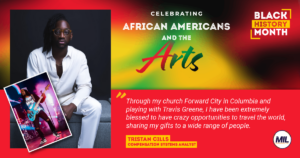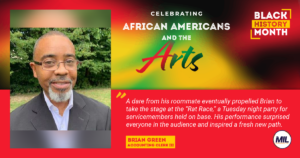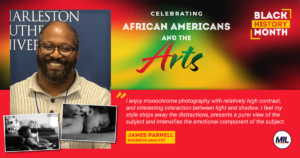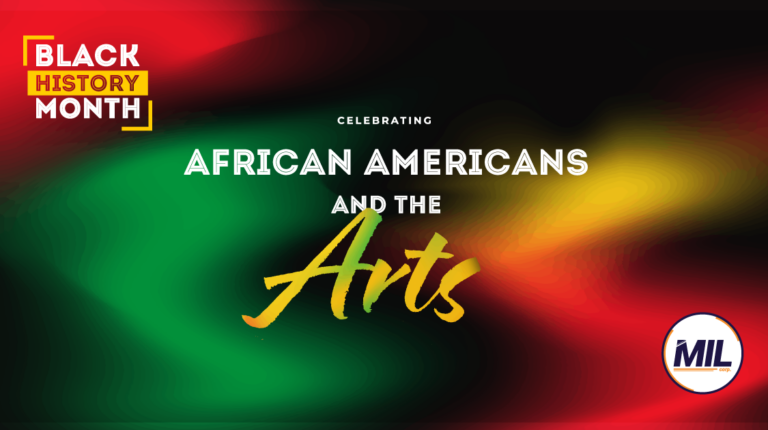In observance of Black History Month, The MIL Corporation (MIL) pays tribute to the humanity and resilience of African Americans whose journeys paved the way to the freedom, opportunity, and cultural diversity we all enjoy today. Throughout the month of February, MIL joins the rest of the Nation to remember and honor the struggles of these African American trailblazers and to celebrate their many triumphs and countless achievements.
In keeping with this year’s focus on “African Americans and the Arts,” MIL will be commemorating Black History Month by reflecting on the contributions of African American artists whose visionary works in visual, performing, and literary arts helped to shape our uniquely American cultural landscape. Take a moment to envision a world without Scott Joplin, Gordon Parks, and Jean-Michel Basquiat. Album collections minus Ella, Quincy, and Stevie. Opera houses never transported by the soaring voices of Marian Anderson or Leontyne Price. Dance stages without Misty Copeland or Bill Robinson. Or library bookshelves that never held the insightful words of Maya Angelou, Alex Haley, or James Baldwin.
African American artists have entertained, thrilled, and enthralled us for generations and continue to serve as an inspiration to countless other creative minds. To turn a spotlight on several of those resident creative minds at MIL, we will be introducing you to a few of the African American artists among your MIL colleagues who are using their innate talent, finely tuned skills, and artistic aesthetics to create, perform, and express their own imaginative art.
Please join us in meeting — Mike Ogletree’s Soul Infusion
___________________________

Mike Ogletree’s Soul Infusion
“For me, music and life are all about style.”
~ Miles Davis
Michael Ogletree’s style of music is soul-infused, heavy modern and instrumental rock, with R&B styled vocals. To Mike, making music is about cooking up a melting pot of influences and genres to create his own original strange brew of sounds. His goal, to bring together a fusion of sound that everyone can enjoy. From his perspective, music should be fun and not too rigidly defined. “It was meant to express feelings and tell a story. Mixing sounds helps people tell stories that are as unique as they are.”
Mike began his life of music over 20 years ago when he first picked up a trumpet hoping to emulate his big brother, a saxophone player. Since then, music has been a constant in his life, a way to express himself and entertain others in the process.
When not mixing it up with his music, Mike works in MIL’s Procurement Department as a vendor liaison while also attending the College of Southern Maryland.
*****
Miles Dewey Davis III was a trumpeter, composer, bandleader, musical innovator, and legendary figure in the world of American Jazz. Considered the father of jazz fusion, Davis brought together funk, rock, and R&B sounds with electric guitars and electronic keyboards to create a new progressive style of jazz.
___________________________

Tristan Cills, sharing the Word through music
“You need to do what feels right but equip yourself with the tools to get the job done. Do whatever it takes to improve, learn, and conquer.”
~ Andrew Gouché
Tristan Cills grew up in a musical family with a mother who encouraged her children to learn the piano. But as Tristan remembers it, it was always the song’s bass line he was humming in the back of the family minivan. Bass guitar, not piano, was a natural fit.
Fast forward quite a bit, and Tristan has 20 years of musical performance under his belt, with 14 years at a high professional level. According to Tristan, “It’s simple. I’m a musician. I play bass guitar, guitar, and a little piano.” Adding, “Bass guitar is my primary instrument. I can play every genre, from jazz, folk, blues, pop, and rock, to my favorites–gospel and R&B.” He also enjoys assisting worship at his church and being on the road with his friend and world-renowned, award-winning gospel artist Travis Greene, and everywhere else playing good music.
Travis notes musical influences like the traditional Pentecostal-style African American church he grew up in that used music as an integral part of their worship—along with his Caribbean parents that accompanied his early years with bass heavy music. All his early influences eventually came together to create the soundtrack for his own musical style and sound. Music he hopes connects with people across societal boundaries.
“Through my church Forward City in Columbia and playing with Travis Greene, I have been extremely blessed to have crazy opportunities to travel the world, sharing my gifts to a wide range of people.” But these days his primary focus is on ministry. “The impact of the Church locally and globally cannot be understated. Ministry has allowed me to travel to all over the U.S., Canada, Europe, South America, and Africa sharing the Gospel. I do not discount other styles of music or events. I am still fortunate to play the occasional wedding and corporate events all around the state.”
Along with sharing his musical gift to uplift and inspire, Tristan works as an MIL Compensation Systems Analyst at the U.S. Department of State in Charleston and shares his life and love with wife Kashayla.
“I love my wife Kashayla who also works for MIL. We welcomed our son Nikko on 12/30/23. I also love MIL. It’s been an honor working here.”
*****
Andrew Gouché is considered the godfather of gospel bassists for the innovative sound-fusing blues, funk, R&B, and rock that helped make bass guitar a staple of modern Gospel music. Along with grabbing a Grammy for his work on Mary Mary’s Thankful album, Gouche has made joyful noise with a spectrum of genre spanning artists from Prince, Madonna, Chaka, and Snoop to Andraé Crouch and The Winans.
___________________________

Brian Green: It’s a family affair
“I’m still on a mission to spread the funk.”
~ Sly Stone
I guess you could say it’s in the DNA for Brian Green. His grandfather was a trombone player in the legendary Duke Ellington band and his dad was a singer, so Brian’s musical gift for Go-Go was probably no surprise to those in the know.
Brian’s natural talent first revealed itself in the early 1980s while he was serving in the U.S. Air Force. After listening to his roommate’s rapping rhymes, Brian thought, I can do better. And then he did. A dare from his roommate eventually propelled Brian to take the stage at the “Rat Race,” a Tuesday night party for servicemembers held on base. His performance surprised everyone in the audience and inspired a fresh new path.
Brian’s new direction began with performing in shows outside of the Rat Race along with the studio recording sessions that followed. His brother was so impressed with the music Brian was making at the time, he began playing his tapes for his barbershop patrons. And then one fateful day, Big Tony from the Go-Go band Trouble Funk heard one of his recordings and expressed an interest in working with him. Brian’s music career was really starting to pick up momentum.
With his military service behind him, the early 1990s found Brian making music and touring through Asia and Europe, performing in London, Frankfurt, Tokyo, and Osaka—and rapping on the same stage as headliners like the Red Hot Chili Peppers and War. Brian eventually went on to produce music, including rapping on the title track of the 1998 Bruce Brown film Street Wise (Taraji P. Henson’s first movie). He even wound up in the movie’s final cut, playing a character named 11:30. But if you ask Brian, he’ll tell you that the highlight for him was spending time with and getting to know fellow musicians—hanging on Bootsy Collins’ tour bus and becoming friends with Go-Go music legend Chuck Brown.
Once those heady days of touring and performing wound down, Brian again launched himself in yet another new direction in 2000. This time following an aptitude for accounting and eventually finding a home on MIL’s Accounts Payable team in 2016.
But never fear, there’s yet another generation of Greens carrying on the family’s musical tradition. Brian’s son is a rapper and music producer, and his daughter plays multiple instruments including the trombone, which she once played as a member of the Redskins band.
*****
Sylvester Stewart (aka Sly Stone) is considered one of the forefathers of funk music. An African American musician, singer, songwriter, record producer, and influential frontman of Sly and the Family Stone, Stone created a unique genre fusing sound that other artists have been sampling ever since. Stone’s riffs show up in literally hundreds of musical recordings, in songs like LL Cool J’s Mama Said Knock You Out, Janet Jackson’s Rhythm Nation, and the Beastie Boys’ Egg Man. Sly and the Family Stone were honored for their pioneering sounds at their induction into the Rock and Roll Hall of Fame in 1993.
___________________________

James Parnell in light and shadow
“You should be able to look at me and see my work.
You should be able to look at my work and see me.”
~ Roy DeCarava
People create art because it’s their passion and escape. MIL staffer James Parnell creates his art to capture life in its purest and most organic form. With a love of photography formed in his earliest years, James has pointed his unfiltered lens at the faces of newborn babies as a professional in-house photographer as well as at countless other subjects to forever memorialize a moment in time. Since picking up his first point-and-shoot camera, through his middle school days learning the basics of black and white photography and darkroom film development, James transformed an early fascination with his dad’s 35 mm camera into a hobby, then a craft, and eventually into an artistic expression of his own personal perspective.
With no formal training outside of that middle school Technology class, James learned the craft of his art by doing. Asked to describe his artistic point of view, James replied, “I enjoy monochrome photography with relatively high contrast, and interesting interaction between light and shadow. I feel my style strips away the distractions, presents a purer view of the subject and intensifies the emotional component of the subject.” Also adding that his unfiltered vision reflects his desire to “get it right in the camera.” He prefers not to fuss with too much post-processing through ”Photoshopping” or filtering his images. His goal is to get his camera settings, lighting, and composition right in the moment.
Along with photographing some of life’s first moments, James has also shared his vision and talent to create portraits and professional images for his friends and family. His affinity for photographing people has led him to appreciate the challenges of photographing the many shades and tones of his human subjects. “As a student of physics, I know that darker objects absorb more light than lighter subjects, and a photograph is a drawing of light,” he noted, adding that within an African American family, it’s common to encounter a wide variation in skin tones. For the past 10 years, he’s focused his attention and artistic eye on properly representing the full spectrum and diversity of the subjects stepping in front of his lens.
When not freezing time with his camera, James serves as a Business Analyst at MIL. Since 2019, he’s supported MIL’s Department of State mission in Charleston, SC., applying his love of technology and technical training to lead continuous improvement projects, identifying areas to streamline through business process reengineering and automation.
*****
Roy DeCarava was a widely renowned African American fine art photographer with a career spanning over five decades. From the 1940s through the 1990s, DeCarava used his art to capture everyday black life, with some of his most influential work capturing images of the Harlem Renaissance. In 2006, DeCarava was awarded the National Medal of the Arts, the Nation’s highest award given to artists and arts patrons and organizations.
